Advertisement
Trees add beauty to your home, keep your house cool, and lower heating costs by breaking cold winds. They also provide shade, reduce noise pollution, minimize or prevent water damage, and protect your home from soil erosion. Additionally, trees bring in fresh air by absorbing carbon dioxide and releasing oxygen.
An even greater advantage is that trees increase your property’s value. Many prospective buyers will prefer a home with mature and healthy trees. You’ll generally find that though two properties have the same features, the one with trees will be priced higher than the other.
So, if you have trees in your home, it’s best to take good care of them. They’ll serve as a long-term investment that’ll bring in good returns when you decide to sell your home. Besides that, you’ll enjoy the everyday benefits mentioned, such as fresh air and much more.
Here are three ways to care for your trees:
- Keep The Roots Safe
One way to maintain healthy trees is by protecting the roots. Essentially, the roots need oxygen to absorb nutrients. So, the soil in the root area must have enough air space to ensure this. It’s therefore advisable not to park your car or leave heavy equipment under your trees. Doing so causes the soil to become compacted. This way, it’s challenging for oxygen and water to get into the roots. As a result, the roots slowly die, and the trees’ health weakens over time.
Protecting the soil within your trees’ root protection zone (RPZ) or critical root zone (CRZ) is also best. The RPZ or CRZ is an imaginary or invisible circle running just outside or along a tree’s drip line—the area directly under the outermost circumference of a tree’s branches or canopy.
The roots within the RPZ are the most critical and can be easily affected by disturbance. Therefore, it’s advisable not to add or remove the soil within your trees’ CRZ. Further, it’s best not to tamper with the soil grade within your trees’ CRZ. Only a professional arborist like Pelfrey Tree Service should handle these tasks. Otherwise, you risk harming your trees’ soil structure and roots. This negatively affects your trees’ health, weakening and killing them slowly.
- Practice Proper Pruning
Proper pruning enhances a tree’s health, appearance, growth, shape, and stability. You can prune your trees yourself, too, with proper guidance. If you’d like to do so, consider the following:
- When To Prune
It’s best to prune in the winter months or the late fall. This is because, in most trees, the sap isn’t running during such times. So, pruning during these periods doesn’t stress the trees. Besides, most pests are dormant in the winter months and late fall. Pruning at this time is best because there’s a lower risk of infestation.
- How To Prune
It’s best first to acquire the right tools for pruning. In most cases, the task requires safety glasses, loopers, hand pruners, and pruning saws. You can buy these pieces of equipment as a long-term investment or rent them to save money.
With the right tools, you now begin the task. Here are some pruning guidelines you can consider:
- Apply the right pruning techniques. For instance, cut a branch at the point where they connect with another one. Cut above a bud but not too close to avoid damaging it. Additionally, your cuts should be at a 45° angle to prevent water from collecting around the wound, causing disease or hindering proper healing.
- Remove dead, diseased, or broken branches. This prevents unwanted organisms like pathogens and pests from intruding and deteriorating your trees’ health.
- Eliminate crossing or entangled branches so light and air can circulate sufficiently for proper tree growth.
- Remove lower branches that hinder light from getting into the area below the tree. If any lower branches are likely to get damaged by passersby or vehicles, get rid of them, too. As mentioned, open wounds can allow unwanted organisms into trees, causing more damage.
- If some top branches are in contact with electric or telephone wires or hanging over the roof, remove them. These kill your curb appeal and pose safety hazards.
If you’re certain you can prune your trees yourself, you’ll save money on hiring a professional. Nonetheless, it’s best to leave the task to an expert if you aren’t. They know the branches to eliminate and the best techniques to apply. Generally, they’ll do a more efficient job within a reasonable time.
- Mulch Regularly
Mulch keeps your trees in good shape by cooling the soil and enhancing its texture. It also preserves moisture and reduces weeds. Therefore, apply 2-4 inches of cocoa hulls, pine needles, and other biodegradable mulch at least once a year. The materials should start 1-2 inches from the tree trunk, going to the drip line.
Final Thoughts

Trees are valuable assets to have in your home. They bring fresh air, reduce noise, keep your house cool, increase property value, and do much more. It’s, therefore, vital to take proper care of trees to keep them in good shape.
If you have or would like to have trees in your home, this article provides some tips on caring for them. As advised, it’s best to protect the roots, ensure proper pruning, and mulch at least once a year. You can easily keep the roots safe, as this piece recommends. Nevertheless, if you find pruning and mulching difficult, hire a professional to handle the tasks on your behalf.

